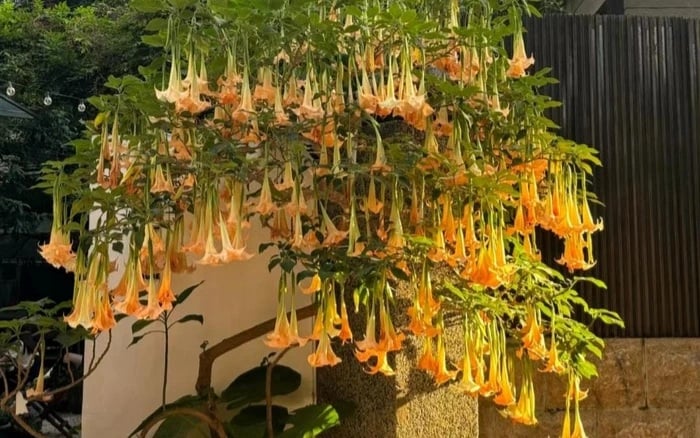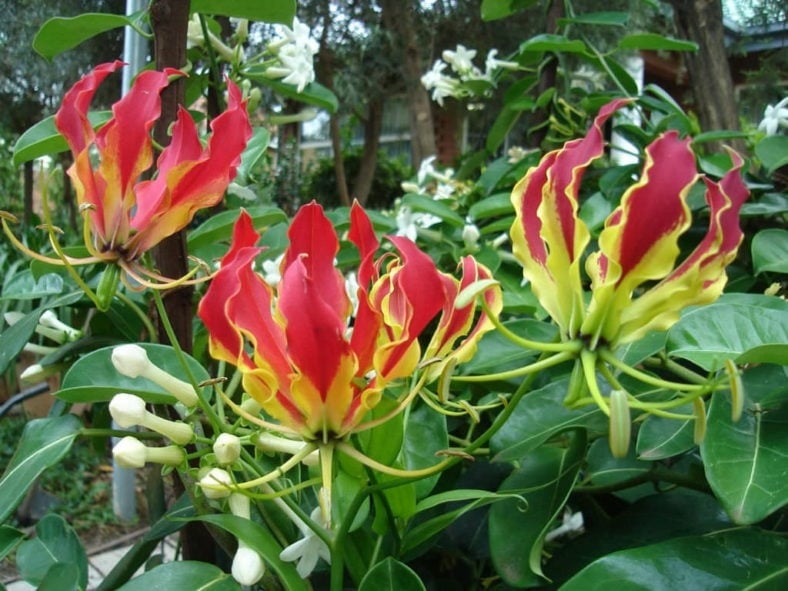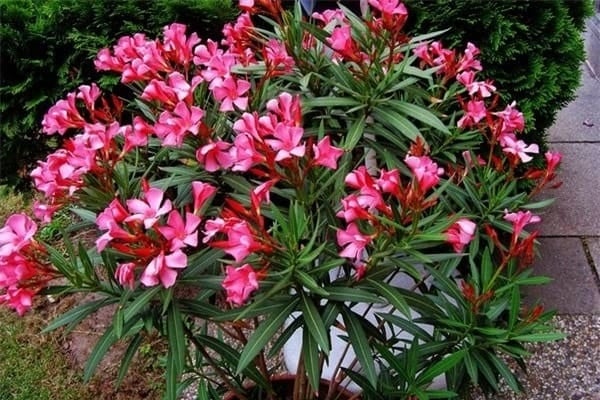Some plants are believed to bring bad luck and are therefore not recommended for indoor planting. These plants may have poisonous or thorny characteristics, or they may be associated with negative meanings and superstitions.

What is the “five-flower” that ancient people advised against planting indoors?
Having these plants indoors can lead to accidents, poisoning, and even hospitalizations, resulting in financial losses, health deterioration, and obstacles to earning a living. In more unfortunate cases, it could pose a risk to one’s life. Therefore, regardless of their aesthetic appeal, it is best to refrain from planting them indoors.
1. Ancient Wisdom: Avoid the Red Spider Lily to Ward Off Misfortune
Among the myriad of flowers, the red spider lily, or Lycoris radiata, stands out with its unique beauty and mysterious hues. Native to East Asia, this perennial herb goes by several names, including Hồng Hoa Thạch Toán, Long Trảo Hoa, and Mạn Châu Sa Hoa.
While it comes in yellow and white variants, the red spider lily, with its blood-red petals, leaves the most striking impression. Its short life cycle takes only about a dozen days from planting to blooming and withering. It flowers during the summer, and interestingly, it can bloom directly from the bare stem without any leaves.
The red spider lily emits a distinct fragrance at night, attracting moths and adding to its air of mystery. At the same time, its unique growth habit gives it an enchanting, almost deadly allure.

This distinctive growth habit has earned the red spider lily a reputation as a bewitching woman, exuding a fatal charm.
In different cultures, the red spider lily holds varying symbolic meanings. In Japan, it signifies painful memories; in Korea, it represents longing; and in China, it stands for pure beauty, separation, and grief. Ultimately, it is seen as a flower of separation and despair.
Legend has it that this flower grows exclusively along the path to the underworld. As spirits cross the Nại Hà Bridge over the Vong Xuyên River, they impart their memories to the red spider lily. Thus, it is regarded as a flower of the underworld, guiding spirits on their journey, much like street lamps in hell.
Given its association with death and the horrors of hell, the red spider lily is considered an ill omen. Whether it be profound sorrow or deep affection, the red spider lily absorbs these memories. For this reason, it is one of the “hell flowers” that ancient wisdom advises against planting indoors.
From a health perspective, the bulbs of the red spider lily contain potent toxins, including lycopene and galantamine. Ingesting these bulbs can lead to poisoning symptoms such as nausea, vomiting, diarrhea, abdominal pain, and nerve paralysis, as evidenced by research.
The leaves of the plant also contain toxins, albeit at lower concentrations. Leaf extracts can inhibit the growth of other plant species, resulting in a lack of weeds or other plants in the area where the red spider lily grows.
Therefore, out of caution, ancient wisdom recommends refraining from planting this flower indoors to avert potential misfortune.
2. Ancient Wisdom: Datura Within the Home Brings Danger
Datura, or Datura metel, is a strikingly beautiful plant with large, bell-shaped flowers in vibrant colors such as yellow, red, orange, purple, and white. It belongs to the Solanaceae family and is commonly known as devil’s trumpet or angel’s trumpet. Despite its allure, ancient wisdom cautions against planting it indoors.
This plant, which originally grew wild in fields and mountainous regions, has made its way into homes due to its aesthetic appeal. However, beneath its captivating beauty lies a deadly secret. Datura contains potent toxins throughout its body, making it extremely hazardous.
Its fruits and seeds are highly toxic and contain protein-degrading enzymes that can damage cell membranes, causing swelling of the mouth and tongue and, in severe cases, difficulty breathing. The leaves also contain certain alkaloids that can lead to poisoning symptoms if accidentally ingested, including dry mouth and tongue, impaired vision, rapid heartbeat, and hallucinations. Even the flower’s nectar can be harmful, potentially causing allergies upon skin contact.
Despite its toxicity, datura has its uses. The Maya used it medicinally, and in ancient Greek mythology, it was a symbol of Poseidon, the god of the sea. In medieval Europe, it was believed to be a “pet” of sorcerers.
These legends undoubtedly contributed to the mix of fear and admiration that people felt toward this enigmatic plant.
From a modern medical perspective, datura is not merely a poison. Contemporary research has revealed that it contains specific chemical components that can be harnessed for medicinal purposes.
Indeed, scientific studies have confirmed the presence of highly toxic alkaloids in datura. Even minimal exposure to these compounds can induce severe adverse reactions, such as cardiac arrhythmias, hallucinations, and even comas.
The alkaloids found in datura are also used in the synthesis of certain psychiatric medications. However, this process demands precise ratios and carries the risk of side effects if not carefully administered. Consequently, many countries have stringent regulations governing the use of these drugs.
Given the potential dangers associated with datura, it is advisable not to plant it indoors, especially in homes with children who might be enticed by its attractive flowers and fruits, posing a risk of accidental ingestion.
For those who insist on cultivating this plant, it is crucial to keep children and pets away from it and to inform others about its toxicity.
3. Ancient Wisdom: Oleander Brings Health Hazards
Oleander, or Nerium oleander, is a plant native to the Mediterranean region with several advantages. It is drought and cold tolerant, and its flowers are delicate and vibrant, making it highly ornamental. However, ancient wisdom considers it an unlucky plant that may attract unclean entities, and thus, it is not recommended for indoor planting.
Much of the superstition surrounding oleander stems from its highly toxic nature. It contains a highly poisonous compound called organocyanogen, which interferes with the normal respiratory function of human cells.
The leaves, roots, and bark of the oleander are particularly rich in this toxic compound. When ingested, it is readily absorbed through the mouth and stomach lining, leading to poisoning.

Symptoms of poisoning can include abdominal pain, nausea, vomiting, dizziness, and even death.
Because of its toxicity, oleander has earned a reputation as a “ghost-calling flower,” serving as a warning to stay away from this deadly plant.
Despite its toxicity, oleander is widely planted along streets and in amusement parks due to its air-purifying capabilities and ease of cultivation.
Research has shown that oleander can act as a miniature air filter, effectively absorbing air pollutants such as formaldehyde and dioxin. Additionally, it helps mitigate the problem of haze in the environment.
Given its unique ability to improve air quality, relevant departments have chosen to plant oleander on a large scale, despite its toxicity, to maximize its positive impact in this regard.
To prevent accidental exposure, there are public awareness campaigns and information dissemination about the extreme toxicity of oleander, reminding people to stay away from this plant.
By understanding the true nature of this plant and taking appropriate precautionary measures, we can avoid potential dangers while still enjoying the benefits of the green environment it provides.
4. Ancient Wisdom: Night-Blooming Cereus at Home Brings Fleeting Joy
The night-blooming cereus, or Epiphyllum oxypetalum, is a stunning flower known as the “beauty under the moon” or the “queen of the night.” It is unique in that it blooms at night, contrary to the sun-loving nature of most flowers.
The night-blooming cereus has large white flowers that usually bloom only once during the night in June or July. The delicate, thin petals of the cereus, combined with its golden stamens, create an elegant appearance.
On summer or autumn nights, under the soft moonlight, the cereus slowly unfolds its petals, showcasing its full splendor. However, its nocturnal nature is not highly regarded by ancient wisdom.
According to ancient beliefs, sunlight and daytime symbolize positive yang energy, representing health and vitality, while nighttime represents heavy yin energy.
The night-blooming cereus, with its contrary blooming habit, evokes a sense of strangeness and incomprehensibility, leading ancient people to associate it with “seducing evil spirits” during the night.
Moreover, the cereus’ bloom is fleeting, and its beauty is short-lived. It serves as a reminder that time is fleeting, and good things are often short-lived.
Therefore, ancient wisdom advises against planting the night-blooming cereus indoors, as its beauty is fleeting, and its association with the night may influence the mood and vitality of the household.
5. Ancient Wisdom: Gloriosa Superba Brings Bad Luck and Repels Wealth
Gloriosa superba, commonly known as flame lily or tiger claw, has a silly name, but its flowers are dazzling and graceful. However, don’t let its vibrant appearance and whimsical name fool you.
Gloriosa superba, belonging to the Colchicaceae family, is highly toxic and potentially deadly to humans and large animals, especially its root tubers, which contain potent toxins.
Ingesting this plant can lead to nausea, abdominal pain, diarrhea, blood disorders, intestinal obstruction, internal bleeding, seizures, coma, and polyneuropathy. Therefore, ancient wisdom advises staying away from this flower to ensure the safety of your family.
In conclusion, ancient wisdom cautions against inviting bad luck and potential harm by planting these flowers indoors. If a family member or pet consumes the toxins from these flowers, it could result in hospitalization and even life-threatening situations.
Consequently, health deteriorates, finances suffer, and the family faces difficulties. Instead, opt for auspicious plants with medicinal and culinary values, such as golden money plant, jasmine, goji berry, pomegranate, and hibiscus.
The Magic of Peach Blossoms: Unveiling the Secrets of this Captivating Flower.
Truc Dao is a captivating and graceful tree that exudes a unique charm. Uncover the fascinating meaning behind this tree, and explore its distinctive features, cultivation methods, and essential care tips. Discover the allure of the Truc Dao tree and learn how to incorporate its beauty into your life.





































